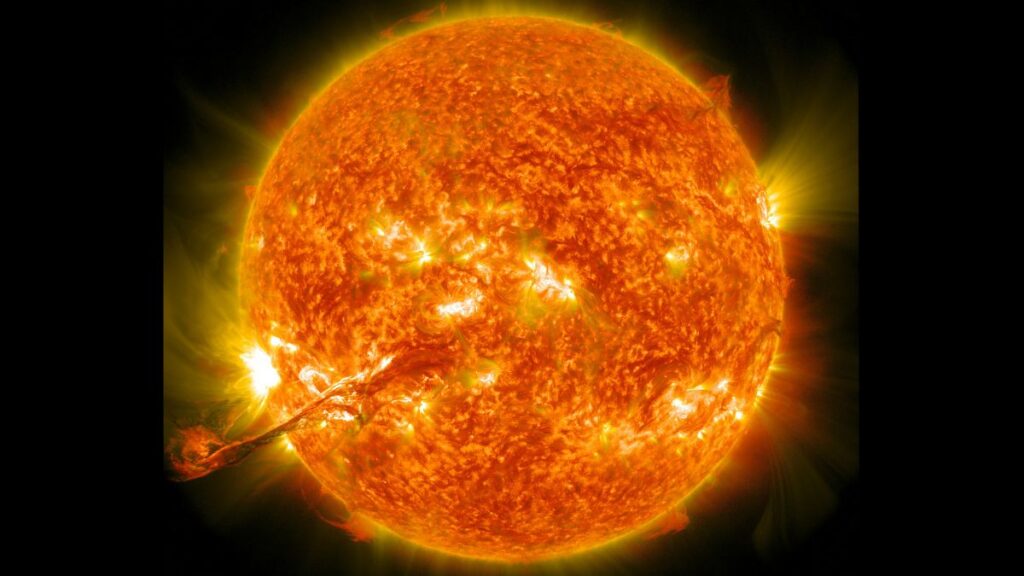
Speaking with the meticulous precision characteristic of a scientist, Mark Miesch details his significant work at the National Oceanic and Atmospheric Administration’s Space Weather Prediction Centre (SWPC). “My primary responsibility,” he explains, “is to seek out the latest research advancements within the space weather community and translate these discoveries into practical applications.
These applications are designed to enhance our space weather forecasting capabilities, improving our understanding of phenomena such as coronal mass ejections (CMEs) and solar flares. Additionally, I study what I refer to as ‘the seasons of the sun,’ which essentially represent the solar cycle. For centuries, humans have observed sunspots—dark spots on the sun caused by magnetic fields generated below its surface.
These magnetic fields emerge through the sun’s surface, creating sunspots. Historically, people have noticed varying levels of activity on the sun, with some days being very active with numerous sunspots and other days being quiet with almost none. Nearly 200 years ago, scientists discovered that this activity follows a roughly 11-year cycle. Each sunspot typically lasts from a few days to a few weeks. Over the span of 11 years, the number of sunspots fluctuates, defining what I call ‘the seasons of the sun.’
Search
Recent Posts:
- OpenAI Brings ChatGPT to be used in WhatsApp: Here’s How It Works and What You Can Do To Use It.
- Realme 14x 5G: A Budget Smartphone With Premium Features.
- Exploring Apple Genmoji: A New Era of Custom Emoji Creation.
- 2024 United States Presidential Election: Donald Trump Declares Victory in 2024 Presidential Election
- Chancellor Olaf Scholz’s Visit to India: Advancing Indo-German Cooperation on Defense, Trade, and Regional Stability.
The Cyclical Nature of Solar Activity and Its Impact on Modern Society
Miesch elaborates on the broader implications of these solar cycles. “During periods of high sunspot activity, known as ‘solar maximum,’ the sun experiences heightened activity that can last for two to three years. This period is followed by a decline in activity, leading to a ‘solar minimum.’ This cyclical pattern, from solar maximum to minimum, has been repeating itself for as long as we can trace. Recent data suggests that solar activity is currently on the rise, entering a phase of solar maximum expected to peak throughout 2024 and 2025. The previous cycle, which peaked around 2014, was notably one of the weakest in a century.
In contrast, the current level of solar activity is more typical, with the sun exhibiting a greater degree of activity than we have seen in the last 20 years.” He underscores the relevance of these patterns to life on Earth, explaining, “Our modern societies have become increasingly dependent on technologies such as electrical power grids, satellites, global navigation systems, and air travel. This dependence makes us particularly vulnerable to space weather events, including those caused by solar storms.”
The Impact of Coronal Mass Ejections: Spectacular Auroras and Solar Storms
Miesch goes on to describe the different types of solar storms and their effects. He notes how recent solar activity has created spectacular auroras, even in locations like Ladakh, which are far removed from the usual aurora zones. “Solar storms, especially those involving Coronal Mass Ejections, are comparable to pieces of hot, magnetized gas being hurled from the sun. These Coronal Mass Ejections travel through space, and if they encounter Earth’s magnetic field, they cause it to compress and wiggle. This interaction accelerates particles, primarily electrons, which then follow magnetic field lines and enter Earth’s atmosphere near the poles.
When these electrons collide with atmospheric molecules, they cause the air molecules to glow, resulting in the auroras we see.” The significant solar storm in May 2024, which produced stunning auroras visible at lower latitudes, was an example of this phenomenon. “More energetic Coronal Mass Ejections tend to disrupt the magnetosphere more severely, leading to auroras appearing at lower latitudes. Such events are more likely during periods of solar maximum, as observed in May 2024.”
Additionally, Miesch highlights the impact of solar flares, which emit bursts of light at x-ray wavelengths that are invisible to the human eye. “These bursts of light interact with Earth’s atmosphere, ionizing molecules and atoms, and disrupting radio communications—a critical issue for airlines that rely heavily on these communication systems.”
The Crucial Study of Solar Behavior and Its Impact on Human Well-Being
The study of solar behavior, Miesch emphasizes, is crucial for human well-being. “We employ a variety of tools to monitor and study the sun. Among these is the GONG Network, a collection of six solar observatories located around the world, including one in Udaipur, India. These observatories are strategically placed at different longitudes, allowing us to continuously monitor the sun as Earth rotates.
Additionally, we have a fleet of satellites observing the sun in various wavelengths, providing comprehensive data on solar activity. This enables us to detect the emergence of significant magnetic energy in sunspots and predict solar storms. Typically, a Coronal Mass Ejections takes two to three days to travel from the sun to Earth, giving us time to run models on supercomputers and predict the timing and severity of their impact on Earth.”
Reflecting on the sun’s vital role, Miesch’s passion for his work is palpable. “The sun is essential to our existence, providing the warmth necessary for life and enabling the growth of crops that sustain both humans and animals. Beyond its role in sustaining life, the sun offers a unique window into the cosmos. As a star in our own backyard, it serves as a natural laboratory for astrophysics, allowing us to observe processes that occur throughout the universe in unprecedented detail. No other astronomical body provides such an up-close view. The sun forms a profound connection between our daily lives and the broader universe, reminding us of the intricate and vast cosmos we are part of.”
To read more topics, please visit: https://insightfulbharat.com






